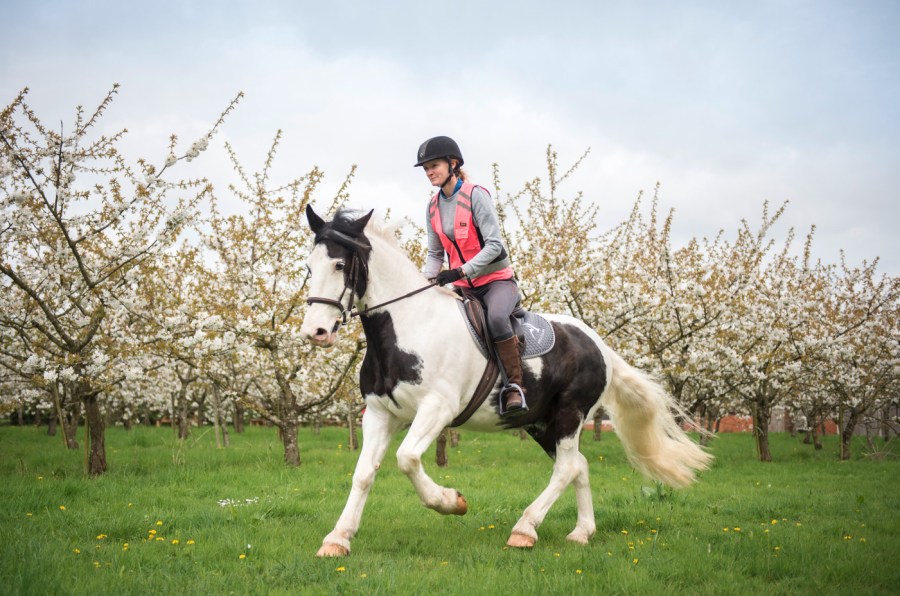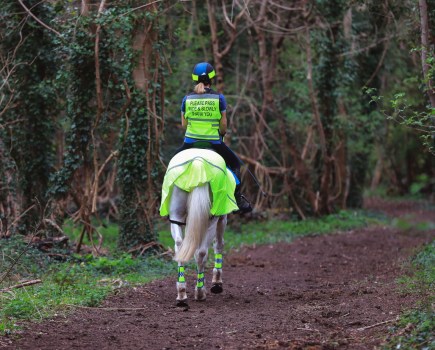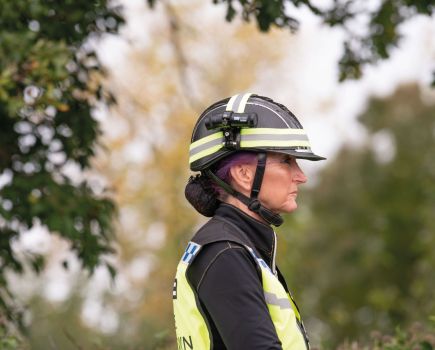In partnership with Wintec Saddles
The pressure placed on your horse’s back when you ride is immense. As you increase your hacking miles, there are simple things you can do to keep your #Hack1000Miles partner sound, happy and comfortable all the way to the finish line.
Bear in mind that horses aren’t designed to carry people. Before domestication, they roamed large areas to avoid predators and search for food and water. As a result, their anatomy is geared towards carrying a stomach full of food and fleeing from danger.
“This means weight is designed to be carried hanging below their spine, but with domestication, we now ask them to carry weight on top of their spine in the form of the saddle and rider,” explains veterinary physiotherapist Hayley Marsh.
“We then ask them to move, which puts a lot of unnatural pressure on their bodies, and we do a lot of things on one side of the horse — usually the near/left side. This can result in sore backs, over-developed muscles in the wrong places, compensations through the body and unbalanced horses – all of which can quickly develop into injuries.”
To counteract the effects of unnatural weight on their back, adds Hayley, it’s vital that horses have a strong core and back muscles.
This comes from getting them to work in a correct and efficient way – stepping through and underneath their body with their hindlegs, engaging their core muscles, lifting through their back and withers, and dropping through their head and neck.
And yes, all this applies when you’re hacking too.
1 Warm up well
Your horse needs to warm up for his hack, just like you would in the arena. Think of your horse as an athlete and ensure he has a sufficient warm up and cool down at the start and end of your hack.
Warming up and cooling down helps to enhance blood flow towards the muscles, making the muscles and joints more supple and helping to prevent injury. It will also dramatically reduce the risk of your horse tying up (azoturia), which is not a condition that only affects elite sport horses – contrary to many riders’ belief.
Remember that cold, tight muscles are much more likely to tear and injure, so warm up well to help reduce the risk of injury.
Hacking tip: Always set off in walk and gradually increase the speed and outline you are asking him to work in. Don’t ask for it immediately. The same goes for cooling off. At least 10 minutes before the end of a hack, stick to walking and start letting him take the contact down and forward to stretch. Don’t drop the reins though – make sure you remain in control at all times.
2 Hill work
Riding up and down hill is excellent for targeting the core as it requires your horse to stabilise himself, particularly when walking downhill. It is also great fun!
Hill work promotes core stability as your horse needs to recruit his abdominal muscles to go up and down and this improves dynamic balance.
It also helps strengthen the hindquarter muscles, either through pushing himself up the hill or maintaining his stability going down the hill.
Hacking tip: It’s great fun to whizz up a hill at gallop, but to be effective hill work needs to be done in a controlled and active way. The steadier you attack hill work, the more balanced your horse needs to be and, therefore, the more he will engage his core muscles to steady himself.
3 Work long and low
Riding your horse long and low, with his hindlegs underneath him and his back arching up like a bridge, engages the abdominal muscles and strengthens the back and topline.
Being able to walk, trot and canter long and low in self-carriage will improve your horse’s topline and core strength — and this is something you can (and should) think about while hacking.
Hacking tip: To correctly achieve the long and low posture, your horse must first engage from behind. An easy way to achieve this is through lateral work, such as leg-yielding. When you are on a suitable track or bridleway, place your inside leg behind the girth in order to ask the inside hindleg to step underneath. Split your hands, drop them to your knees and gently squeeze the reins to encourage the horse to lower his head. As soon as he gives, let your hand go forwards and down, and scratch his neck to reward him.
Your horse must push from behind, not pull himself along, and should be soft and supple through his whole body.
To make this more effective, find something to circle around, like a hedge or a log. Direct your shoulders and the horse’s nose towards it, while using your inside leg to move his hindquarters away.
4 Do plenty of transitions
Transitions are easy to add into your daily hack and you probably already do. But, as well as upward and downward transitions in walk, trot and canter, ask for transitions within the pace — collected canter to working canter, for example.
This will build strength as your horse accelerates and decelerates. It causes him to become more balanced, sit more behind and carry the weight on his hindquarters, not his forehand, thus improving muscular strength.
5 Have regular physio sessions
It doesn’t matter if your horse hacks 10 miles a day, 10 miles a week or more or less than this. Any horse who is ridden regularly, and any horse who is returning to work after some time off, will benefit from being seen by a registered veterinary physiotherapist.
“A regular physiotherapy routine can establish a normal baseline of a horse’s physique and can quickly identify any changes,” says Hayley. “It can prevent injury and a decrease in performance, as well as actually improve performance.
“Massaging and stretching increases your horse’s range of movement, giving him a greater stride length. Through physiotherapy, your horse is assessed, problems areas are located, and any issues are treated, even before these issues may be visible to the eye. This in turn helps you to keep your horse fit and healthy.”
6 Use both sides evenly
Rotate getting on from the left side as well as from the right. It might be tricky at first so ask a helper to hold your horse still, but it’s worth it. If you have to dismount mid-hack, it’s a good idea to get back on from the right sometimes too. Always find something handy to stand on when you’re mounting so that you haven’t got as far to climb — this means there is less of a pull on your horse’s back too.
Doing daily carrot stretches with your horse is also a great way to increase your horse’s flexibility.
This content is brought to you in partnership with Wintec Saddles, durable, comfortable, easy-care, weather-proof saddles for everyone.
You might also like…









